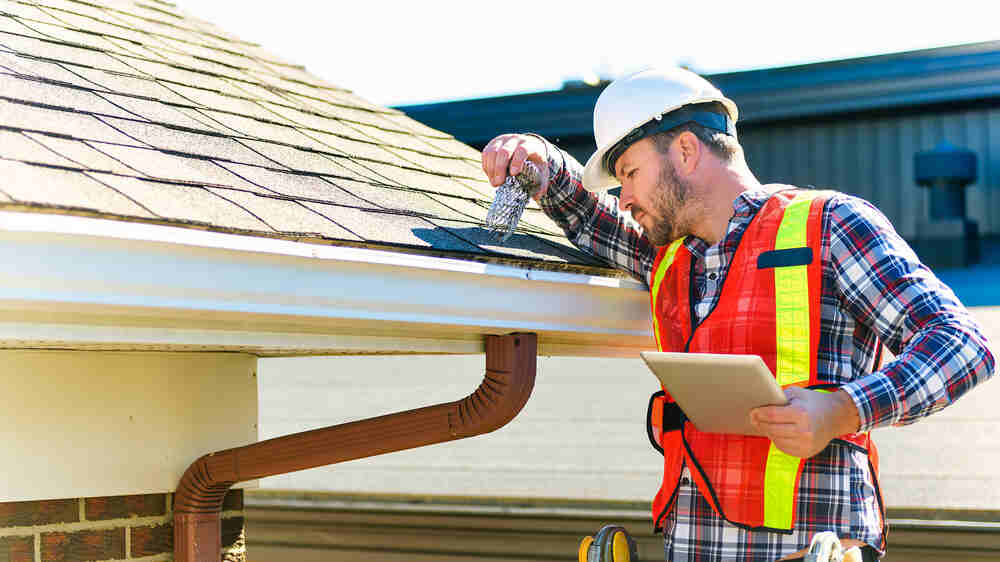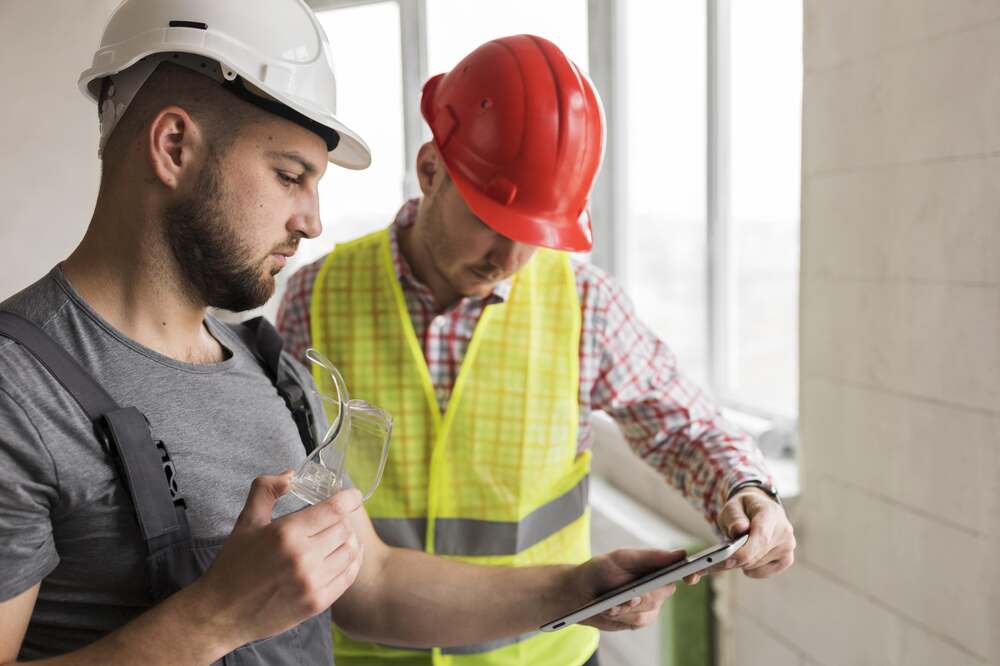
What to Expect When a Roofing Company Provides an Estimate for a New Roof
A new roof is a significant investment, and getting an accurate estimate from a roofing company is the first step. Whether replacing an aging roof or dealing with storm damage, homeowners must understand what goes into a roofing estimate and how to evaluate the details. The global roofing market is expected to expand at a 5.5% compound annual growth rate (CAGR) between 2023 and 2033, reflecting the increasing demand for durable and high-quality roofing solutions. As roofing technology and materials improve, homeowners have more options than ever to enhance the longevity and efficiency of their roofs.
Here are the essential elements of a roofing estimate, what to expect during the inspection, and how to compare estimates from different residential roofing companies to make the best decision.
Table of Contents
Key Takeaways✔ A detailed estimate should specify all materials used, including shingles, underlayment, flashing, and ventilation systems, as material quality directly impacts roof durability and cost. ✔ Homeowners should expect an itemized breakdown of labor charges, accounting for installation complexity, potential structural repairs, and the experience level of the roofing crew. ✔ The estimate should outline costs for tearing off the old roof, disposing of materials, and maintaining a clean job site, as this step adds to labor and waste management expenses. ✔ A reputable roofing repair company will handle permits and inspections to ensure the project meets local building codes, preventing legal and financial issues later. ✔ Reliable professional roofing services provide warranties covering both materials and workmanship, helping homeowners avoid future repair costs. ✔ The estimate should include a realistic start and completion date, factoring in weather conditions, crew size, and any potential delays to keep homeowners informed. |
Scheduling the Roofing Estimate Appointment
The first step in getting a roofing estimate is scheduling an inspection with a roofing company. Many companies offer free or low-cost estimates, allowing homeowners to understand potential costs before committing to the project.
How to Schedule an Estimate
- Research local roofing companies: Look for a roofing repair company with a good reputation, positive customer reviews, and proper licensing.
- Contact the company: Call or fill out an online form to request an estimate. Many professional roofing services respond within a day or two to set an appointment.
- Prepare for the inspection: Make a list of concerns, such as leaks or missing shingles, to discuss with the roofing experts.
What to Expect During the Estimate Appointment
- A professional from the residential roofing company will visit the home for an on-site inspection.
- Homeowners should be available to discuss concerns and ask questions.
- The estimator will take measurements, inspect problem areas, and assess the overall roof condition.

Initial Roof Inspection and Assessment
A thorough inspection is a critical part of the estimate process. Roofing experts will evaluate multiple factors to determine the condition of the existing roof and the best approach for installation.
Key Areas Assessed During the Inspection
- Shingle Condition: The estimator will check for cracked, missing, or curling shingles that indicate wear and tear.
- Flashing & Seals: Flashing around chimneys, vents, and skylights is inspected for leaks or rust.
- Gutters & Drainage: Proper drainage is essential to prevent water damage. The roofing company will ensure that the gutters are functioning correctly.
- Attic Ventilation: Poor ventilation can cause moisture buildup and reduce a roof’s lifespan.
- Roof Decking & Structure: If there are signs of rot or damage, replacement may be necessary before new shingles are installed.
After the inspection, the roofing repair company will provide a detailed estimate outlining the cost, materials, and expected timeline.
6 Components of a Detailed Roofing Estimate
A legitimate estimate from a residential roofing company includes several important components. Reviewing these details helps homeowners avoid unexpected costs and ensures a smooth installation process. Below are the key elements that should be included in a roofing estimate:
1. Material Costs
The estimate should include a comprehensive list of all materials needed for the project. The type and quality of materials chosen will impact both the cost and the longevity of the roof. Homeowners should pay attention to:
- Shingle or Roofing Material Options: Asphalt shingles are the most common choice for affordability and durability, while metal, slate, and tile offer enhanced longevity and aesthetic appeal.
- Underlayment: A critical layer beneath the shingles that adds protection against moisture infiltration and extends the roof’s lifespan. Options include felt and synthetic underlayment.
- Flashing & Drip Edges: These prevent leaks by directing water away from vulnerable areas such as chimneys, vents, and roof valleys. Proper installation is crucial for long-term waterproofing.
- Fasteners, Nails & Adhesives: High-quality fasteners ensure that the shingles remain secure during extreme weather conditions.
- Ventilation Systems: Roof vents and ridge vents promote airflow, preventing issues such as mold growth and ice dams in colder climates.
2. Labor Costs
Labor is one of the most significant portions of a roofing estimate. While it might be tempting to choose the lowest bid, experienced roofing experts often charge higher labor rates for superior craftsmanship, ensuring the roof lasts longer with fewer repairs. A transparent roofing repair company will provide an itemized breakdown of labor costs, allowing homeowners to see exactly what they are paying for.
Labor costs in an estimate should outline:
- Installation Costs: The cost of removing the old roof, installing new materials, and securing everything properly.
- Complexity Adjustments: If a home has multiple slopes, dormers, or skylights, labor costs may increase due to the additional time and precision required.
- Additional Repairs: If rotted decking or damaged framing is found during the installation, the estimate should include potential repair costs.
3. Roof Removal & Disposal
Most projects require removing the old roof before installing the new one. This process involves labor, specialized equipment, and proper waste disposal, all of which should be factored into the estimate. Key considerations include:
- Tear-Off Costs: If the old roof has multiple layers, removal will take longer, increasing labor costs.
- Disposal Fees: Shingles, underlayment, nails, and other materials need to be hauled away to an appropriate disposal site or recycling center.
- Waste Management: Many professional roofing services use dumpsters or trailers to keep the job site clean and organized during the project.
4. Permits & Inspections
A reputable roofing company in Wappingers Falls will handle all necessary permits and schedule inspections to ensure compliance with local building codes. This step is crucial because:
- Permits Are Legally Required: Most local governments require permits for major roofing projects to verify compliance with safety standards.
- Inspections Ensure Quality Work: A city inspector may check the project at different stages to confirm that the residential roofing company follows regulations.
- Failure to Obtain Permits Can Lead to Fines: If a homeowner hires an unlicensed roofing repair company that skips permits, they may face fines or issues when selling the property.
5. Warranties & Guarantees
A high-quality roofing project should come with warranties that protect both the materials and the workmanship. Understanding these guarantees helps homeowners avoid expensive repairs down the road. Types of warranties to look for are:
- Material Warranty: Covers defects in roofing materials. Most asphalt shingle manufacturers offer warranties ranging from 20 to 50 years.
- Workmanship Warranty: Offered by the roofing company, this covers issues related to improper installation. The length of coverage varies by contractor.
- Extended Manufacturer Warranties: Some manufacturers offer extended warranties when their products are installed by certified roofing experts.
6. Timeline & Project Duration
Homeowners should have a clear understanding of when the project will start and how long it will take. This helps with planning and ensures there are no unnecessary delays. A professional residential roofing company will communicate timelines clearly, ensuring that homeowners know what to expect at every stage of the process.
A roofing estimate should include:
- Estimated Start & Completion Dates: Some projects may take a few days, while larger, more complex roofs may take a week or more.
- Weather Considerations: Rain or extreme temperatures may delay the project, so a roofing company should include potential contingency plans.
- Crew Size & Work Hours: Larger crews can complete the job faster, minimizing disruption to daily life.
How to Compare Multiple Estimates
1. Understand the Price Breakdown
Many homeowners make the mistake of choosing the cheapest estimate, assuming all professional roofing services are equal. However, pricing can vary due to:
- Material Differences: Some roofing companies may offer premium materials, while others use lower-cost alternatives. Checking material quality ensures a longer-lasting roof.
- Labor Expertise: Higher labor costs often indicate experienced roofing experts who can guarantee proper installation. Cheaper labor could mean inexperienced workers, leading to long-term issues.
- Scope of Work: Some estimates may include additional repairs, ventilation upgrades, or extended warranties that justify a higher price.
Rather than opting for the lowest bid, homeowners should assess what each roofing company offers and whether it aligns with their long-term roofing needs.
2. Evaluate the Company’s Reputation
A residential roofing company should have a strong track record of delivering high-quality service. While online reviews are a great starting point, homeowners should dig deeper:
- Customer Testimonials: Look for consistent feedback on professionalism, communication, and quality of work.
- Industry Certifications: Reputable companies may be certified by manufacturers like GAF or CertainTeed, which often means they follow high installation standards.
- Local Experience: A roofing repair company that has operated in the area for years is likely familiar with regional building codes and weather challenges.
Homeowners should also ask for references and, if possible, view completed projects before making a decision.
3. Verify Licenses, Insurance & Certifications
A trustworthy roofing company should have the necessary licenses and insurance to protect homeowners from financial and legal risks. Checking for:
- State & Local Licenses: Roofing contractors must be registered or licensed in many states to perform work legally.
- Liability Insurance: This covers damage to the homeowner’s property caused by the crew during the installation.
- Workers’ Compensation: Ensures workers are covered if they get injured on-site, preventing homeowners from being held liable.
The roofing industry had a work injury rate of 59 deaths per 100,000 full-time equivalent workers in 2021, highlighting the importance of safety measures. Due to the high-risk nature of roofing work, homeowners should only hire professional roofing services that carry full insurance coverage, protecting both workers and property owners from potential liabilities.
4. Identifying Red Flags & Avoiding Scams
While many roofing experts operate ethically, some companies use deceptive practices. Homeowners should be wary of the following red flags:
- Lack of Transparency in Pricing: If an estimate is vague or missing details, hidden fees may arise later. A legitimate roofing repair company should provide a clear, itemized breakdown of costs.
- No Warranties or Guarantees: A reliable residential roofing company will stand behind their work. If a contractor refuses to offer warranties for materials and labor, it may indicate subpar craftsmanship.
- High-Pressure Sales Tactics: Some contractors push homeowners to sign contracts immediately, using scare tactics about price increases or limited availability. A reputable roofing company will give customers time to review estimates and compare options.
- No Physical Address or Online Presence: A roofing repair company should have a verifiable business address and a legitimate website or social media presence. A lack of online visibility may indicate an unreliable business.

Next Steps After Receiving the Estimate
Once a homeowner receives an estimate from a roofing repair company, there are steps to take before proceeding with the project. These steps help ensure transparency, proper planning, and a smooth installation process.
1. Review the Estimate Carefully
Go through the estimate in detail to confirm that all materials, labor, and additional costs are included. Make sure there are no vague or missing details that could lead to unexpected charges later.
2. Ask Questions
If anything in the estimate is unclear, reach out to the roofing company for clarification. Homeowners should confirm warranty coverage, estimated project duration, and any potential extra expenses that may arise.
3. Discuss Financing Options
For those concerned about upfront costs, some professional roofing services offer financing plans or payment schedules. Understanding these options ahead of time can help homeowners budget effectively.
4. Schedule the Project
Once a decision is made, coordinate with the roofing company to set a start date and prepare the property. This may involve clearing the driveway, removing fragile outdoor items, and discussing any necessary access arrangements.
Frequently Asked Questions
How do I choose the right roofing company?
Choosing the right roofing company requires thorough research and due diligence. Homeowners should check online reviews, ask for referrals, and verify the contractor’s licensing and insurance. Comparing multiple quotes and assessing warranties offered by different companies can also help in making an informed decision.
What should I look for in a roofing contractor’s credentials?
A reputable roofing repair company should be licensed, insured, and bonded to protect homeowners from liability. It’s essential to verify the company’s experience with specific roofing materials, as not all contractors specialize in every type of roof. Industry certifications, such as those from GAF or CertainTeed, indicate that a contractor meets high installation and service standards.
How long does a typical roof installation take?
The timeline for a roof installation depends on factors like the size and complexity of the roof, weather conditions, and the availability of materials. On average, a standard residential roof can take anywhere from two to seven days to complete. However, unexpected issues such as structural repairs or severe weather delays may extend the project’s duration.
What are the signs that I need a new roof?
Several signs indicate that a roof may need replacement, including missing or curling shingles, leaks, sagging, or visible mold and mildew growth. If a roof is beyond its expected lifespan (typically 20-30 years for asphalt shingles), homeowners should schedule an inspection with a roofing company. Ignoring these warning signs can lead to costly structural damage and interior leaks.
How can I maintain my new roof to ensure its longevity?
Regular maintenance is crucial to extending the lifespan of a roof and preventing expensive repairs. Homeowners should clean gutters, inspect the roof for loose or damaged shingles, and trim overhanging branches that can cause damage. Scheduling annual inspections with a professional roofing services provider ensures that minor issues are addressed before they escalate.
Protect Your Home with Roofer of Wappingers Falls!
For residents in Wappingers Falls, NY, ensuring your roof is in optimal condition is crucial for the safety and longevity of your home. Roofer of Wappingers Falls, located in Wappingers Falls, NY, offers a comprehensive range of services beyond standard roofing installations and repairs. Our expertise includes roof inspections, maintenance programs, and emergency repair services to address unexpected issues promptly. Additionally, we provide siding installation and gutter services, ensuring your home’s exterior is both functional and aesthetically pleasing.
Reach out to experts at Roofer of Wappingers Falls to schedule a consultation or service appointment in Wappingers Falls, NY!
